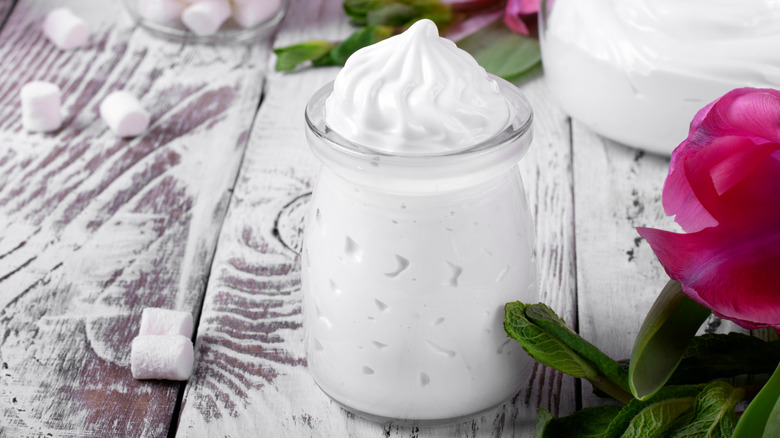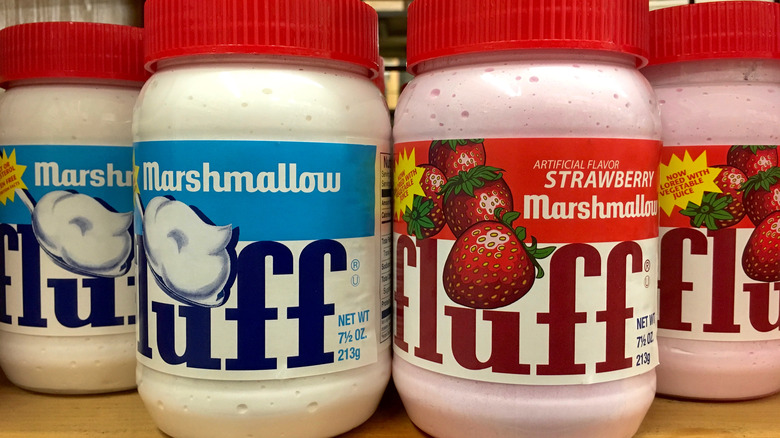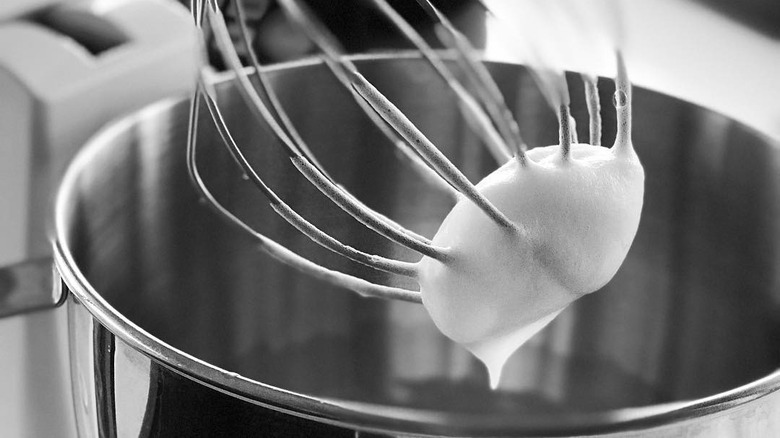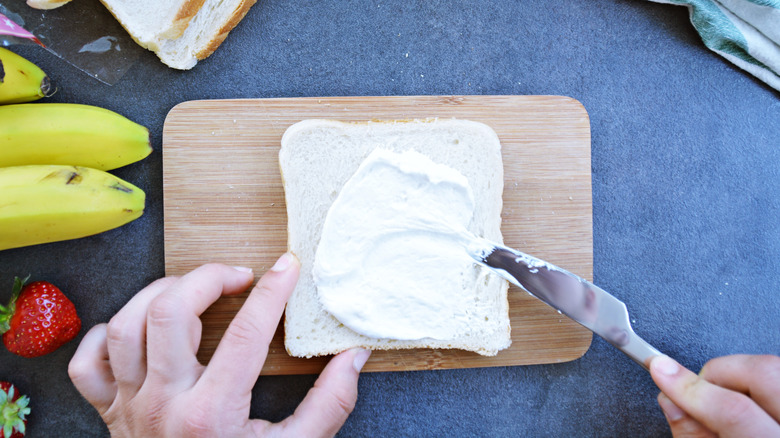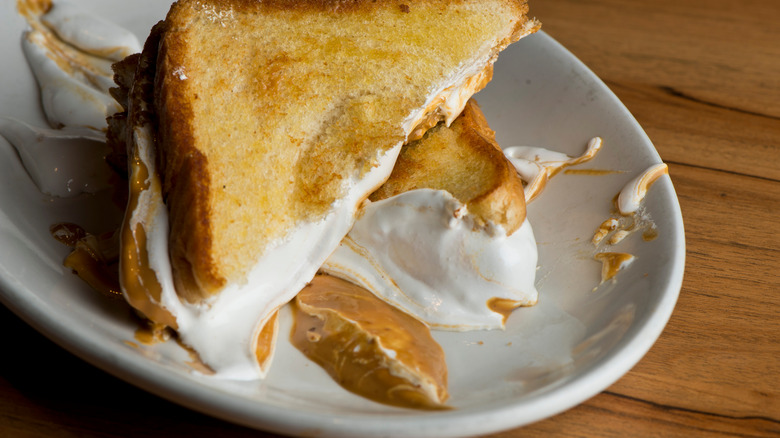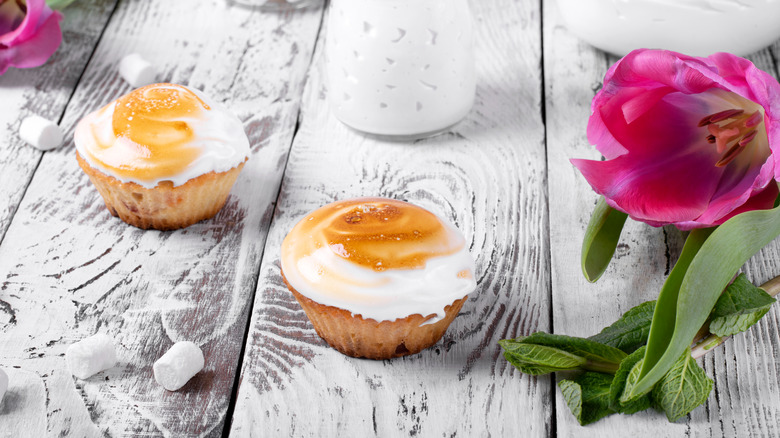What Is Marshmallow Creme And Is It Vegetarian?
If clouds could be jarred, then they would surely be sold as marshmallow creme. This sweet and sticky confectionary fluff is an essential ingredient in many classic recipes from campfire classic s'mores to crooner Elvis' favorite sandwich. All told, this treat has been around for over 100 years, has its own festival, and conjures up all the nostalgic feels with every sugary spoonful.
Marshmallow creme is an ooey-gooey sweet paste traditionally made from sugar, corn syrup, vanilla, and powdered egg whites. It's similar to the regular marshmallows you may get from a bag, but it's softer and much easier to spread. Marshmallow creme is stark white, extremely sticky, and fluffy. It is packaged in jars and usually referred to as "fluff" or "creme."
Marshmallow creme is a baking pantry staple for those who know and love it. However, it can be a little intimidating to folks who haven't ventured outside of the classic mallow scene. But just like the creme, a little information goes a long way.
The history of marshmallow creme
Marshmallow creme has a history that's as rich as it is sweet. According to Eater, the oldest known recipe for the stuff makes "marshmallow paste." It was found in "Fannie Farmer's Boston Cooking-School Cook Book," printed way back in 1896. Multiple companies in Boston began producing the sweet spread soon after and in 1913, brother and sister Amory and Emma Curtis created the first shelf-stable creme available to the public.
In Sommerville, Massachusetts, a man named Archibald Query began selling his marshmallow creme door-to-door after first creating his own version of the treat in 1917. It got the attention of a Boston candy entrepreneurs H. Allen Durkee and Fred Mower, who purchased Query's recipe for $500. Under the Durkee-Mower company, the two men began selling the now famous Marshmallow Fluff. Durkee-Mower hasn't changed much since their humble beginnings and with good reason — they sell seven million pounds of sweet fluff annually (via Mental Floss).
How is marshmallow creme made?
Whether you're grabbing a jar from the grocery store or busting out your candy thermometer to make homemade fluff, marshmallow creme has a short list of ingredients. In fact, if you're feeling a bit adventurous, it's pretty simple to make.
According to Scotch & Scones, marshmallow creme is made by whipping egg whites with cream of tartar until soft peaks form, then slowly drizzling in a boiled mixture of sugar and corn syrup. Vanilla is added to the sugar and egg white mixture and is whipped until the whole thing becomes thick and glossy.
As per Mental Floss, Jet-Puffed and Marshmallow Fluff make marshmallow creme from four basic ingredients: sugar, corn syrup, dried egg whites, and vanilla. Marshmallow Fluff still uses some of the original equipment and recipe from the company's beginning but uses a secret whipping method to create what they believe is a superior puff.
Is marshmallow creme vegetarian?
Every vegetarian has surely lowered their s'more in sadness when they realize that their beloved marshmallows are made with gelatin, a thickening agent that's typically derived from the skin and bones of animals (via PETA). If you don't eat animal products or that generally sounds unappetizing, marshmallow creme might be the perfect alternative.
Regular marshmallows use gelatin to create a firm confection that can be cut and maintain its shape, whereas marshmallow creme is stabilized by egg whites. So long as you're okay with consuming eggs, that makes it a vegetarian delight. If you're vegan, a completely plant-based alternative to marshmallow cream is a similar type of fluff made from whipped aquafaba. According to It Doesn't Taste Like Chicken, aquafaba is the leftover liquid from a can of garbanzo beans. Handled properly, it whips up just like egg whites to help make deliciously sweet vegan marshmallow creme.
What can you make with marshmallow creme?
This gooey fluff lends its super-sweet flavor and luscious texture to a multitude of fan-favorite desserts. Sally's Baking Addiction says that marshmallow creme pairs deliciously with a multitude of flavors like chocolate, banana, and pumpkin.
Possibly the most famous marshmallow creme creation is the fluffernutter. According to New England Today, a fluffernutter is made by taking two pieces of white bread and slathering them with peanut butter and marshmallow fluff. If you want to try it Elvis style, add some sliced banana to the sammie. This Yankee lunchbox regular sticks to more than the roof of your mouth, as it is loved by generations of New Englanders and not easily forgotten by any who give it a try.
Marshmallow creme is an essential ingredient in many other confectionary delights, too. Fudge recipes using fluff abound because marshmallow creme's smooth texture and sweet flavor create rich, decadent treats. Marshmallow creme also makes a scrumptious meringue-style frosting. It can also be torched to provide the nostalgic campfire flavor of s'mores, whether it's spread on top of a cupcake or graham cracker.
Marshmallow creme's nutritional information
When considering what sort of foods you might want to add to your healthy diet, marshmallow creme is probably not the first (or even the last) product that comes to mind. There's good reason behind that, since this fluff is basically spreadable sugar. Much as we love it, marshmallow creme should be kept as a sometimes treat.
That's because marshmallow creme is not a significant source of anything but sugar. It has no cholesterol and no saturated fat, according to Nutritionix. It has similarly low levels of protein, but a tablespoon serving does usually bring in 3.9 grams of sugar and 4.9 grams of total carbohydrates. Medical News Today explains that the body uses carbohydrates and sugar as an energy source, but the sugar that occurs naturally in foods is preferable to added sugar. So, sure, marshmallow creme won't be featured in a Keto diet cookbook anytime soon, but the health benefits (or lack thereof) are not why we indulge in this sugary fluff.
